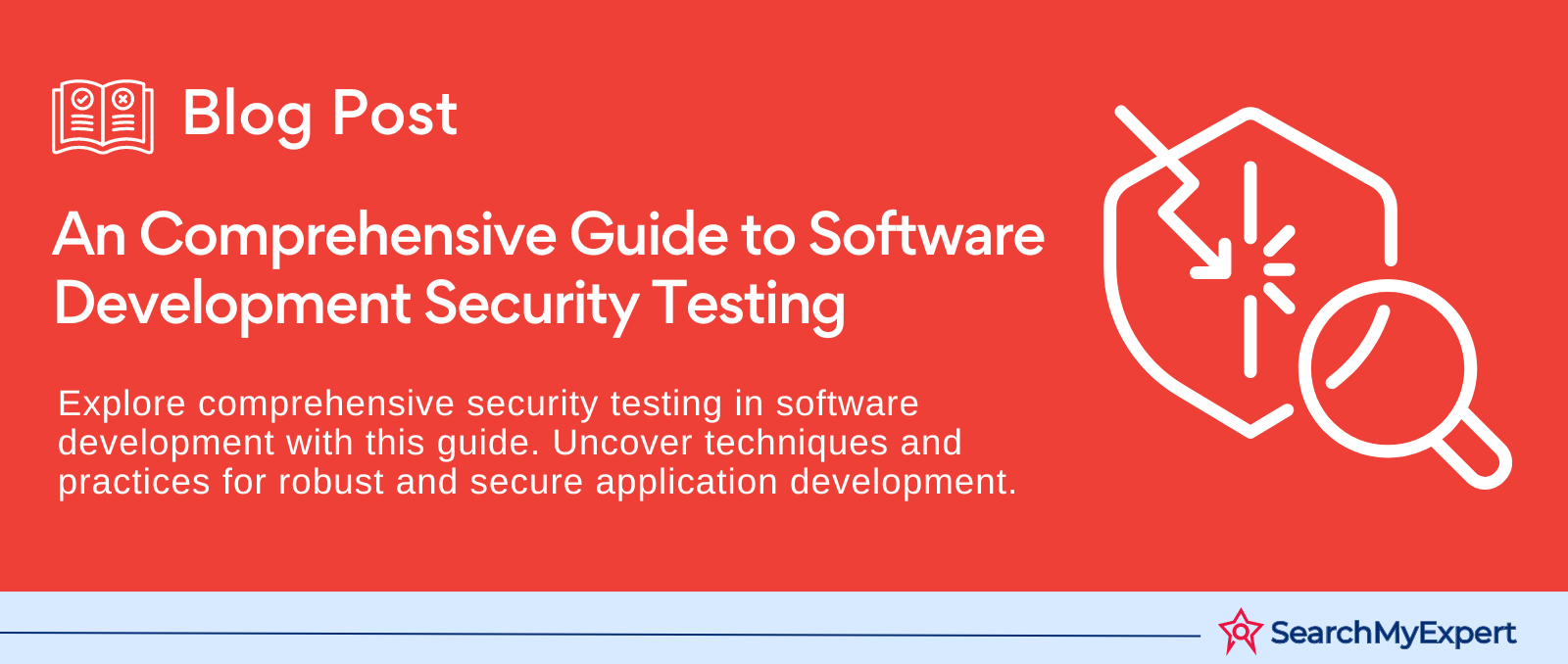Hey there, awesome visitor! 👋 Our website is currently undergoing some nifty upgrades to serve you even better. But don't worry, we'll be back before you can say "SearchMyExpert rocks!"

The Essential Guide to Security Testing in Software Development
In the rapidly evolving landscape of technology, where digital advancements have become the cornerstone of business operations, the importance of security testing in software development cannot be overstated. Security testing, a critical component of the software development life cycle (SDLC), is designed to uncover vulnerabilities, threats, and risks that could potentially compromise the security and integrity of software applications. This process involves the evaluation of software systems to ensure they are free from defects that could lead to security breaches, data leaks, and other forms of cyber-attacks.
The Rising Tide of Cyber Threats
As digital transformation accelerates, cyber threats have become increasingly sophisticated and pervasive, posing a constant challenge to organizations worldwide. These threats range from malware, phishing, and ransomware attacks, to sophisticated nation-state-sponsored cyber espionage. The implications of such threats are profound, not only leading to financial losses but also damaging reputations and eroding customer trust. In this context, the need for proactive security measures has never been more critical. Security testing emerges as a key defensive strategy, enabling organizations to identify and remediate vulnerabilities before they can be exploited by malicious actors.
The Proactive Approach: Integrating Security Testing
Integrating security testing throughout the development lifecycle offers numerous benefits. It allows for the early detection of vulnerabilities, significantly reducing the cost and complexity of remediation compared to addressing security issues post-deployment. This proactive approach also ensures that security considerations are woven into the fabric of the software development process, rather than being an afterthought. By doing so, organizations can foster a culture of security awareness, where developers, testers, and security professionals collaborate closely to build inherently secure applications.
Benefits of Early and Continuous Security Testing
- Reduced Risk of Security Breaches: By identifying and fixing vulnerabilities early, organizations can significantly lower the risk of security breaches and the associated legal, financial, and reputational damages.
- Cost Efficiency: Addressing security issues during the development phase is far less expensive than fixing them after the software has been deployed.
- Compliance with Regulatory Requirements: Security testing helps ensure that software complies with relevant security standards and regulations, avoiding potential fines and legal issues.
- Enhanced Customer Trust: Delivering secure software enhances customer trust and loyalty, which is invaluable in today's competitive market landscape.
- Improved Software Quality: Security testing is part of a comprehensive quality assurance strategy, contributing to the overall reliability and performance of software applications.
Unveiling Fundamental Security Concepts in Software Development
To navigate the complex landscape of software security, understanding fundamental security concepts is paramount. These concepts form the foundation of secure software development, guiding the implementation of robust security measures that protect against a wide array of cyber threats. Let’s delve into some of these core concepts: authentication, authorization, encryption, and access control, and explore common vulnerabilities that these practices aim to mitigate.
Core Security Concepts
Authentication and Authorization
Authentication is the process of verifying the identity of a user or system, ensuring that the entity is who it claims to be. This can involve mechanisms such as passwords, biometric data, or security tokens. Authorization, on the other hand, determines the resources and operations that an authenticated user or system is permitted to access. Implementing strong authentication and authorization mechanisms is crucial for establishing secure access controls within software applications.
Encryption
Encryption plays a critical role in protecting the confidentiality and integrity of data. By converting information into a coded format that is unreadable without a decryption key, encryption safeguards data both at rest and in transit from unauthorized access and tampering. Utilizing robust encryption algorithms is essential for securing sensitive information, such as personal data and financial transactions.
Access Control
Access Control mechanisms restrict access to resources in a system to authorized users, services, or applications. Effective access control is vital for minimizing the risk of unauthorized data exposure and ensuring that users can only perform actions within their permissions. Techniques such as role-based access control (RBAC) and attribute-based access control (ABAC) are commonly used to implement granular access policies.
Common Vulnerabilities
SQL Injection, Cross-Site Scripting, and Buffer Overflows
- SQL Injection occurs when an attacker exploits vulnerabilities in a web application's database interaction by injecting malicious SQL queries. This can lead to unauthorized access to sensitive information, data manipulation, or even database destruction.
- Cross-site scripting (XSS) involves injecting malicious scripts into web pages viewed by other users, potentially leading to data theft, session hijacking, and defacement of the web page.
- Buffer Overflows happen when a program writes more data to a buffer than it can hold, potentially allowing attackers to execute arbitrary code, leading to system crashes or data corruption.
Navigating Through the Landscape of Security Testing Methodologies
In the realm of software development, security testing stands as a bulwark against the multifaceted threats posed by the digital age. Various methodologies, each with its unique focus and capabilities, are employed to unearth vulnerabilities that could compromise the integrity and security of applications. This exploration delves into the primary types of security testing methodologies—static analysis, dynamic analysis, penetration testing, and vulnerability scanning—highlighting their strengths, weaknesses, and optimal application points within the development process. Additionally, we will discuss the synergistic value of combining manual and automated testing approaches to achieve comprehensive security coverage.
Primary Types of Security Testing Methodologies
Static Analysis (SAST)
Static Application Security Testing (SAST) involves examining the source code, byte code, or binary code of an application without executing it. This method is effective early in the development process, even before the code is run, allowing developers to identify and rectify potential security issues at their inception.
- Strengths: It can detect vulnerabilities early, making it cost-effective and efficient. SAST tools are capable of scanning the entire codebase, ensuring thorough coverage.
- Weaknesses: SAST may generate false positives, requiring manual review to verify issues. It also lacks the context of runtime behavior, which can lead to overlooking vulnerabilities that only manifest during execution.
Dynamic Analysis (DAST)
Dynamic Application Security Testing (DAST) assesses an application from the outside, examining it in its running state. This methodology is aimed at identifying security flaws exposed through its interfaces and the environment it operates in.
- Strengths: DAST can identify runtime and environment-related vulnerabilities that SAST cannot. It simulates real-world hacking techniques, providing a practical assessment of an application's security posture.
- Weaknesses: It may miss issues in non-executable parts of the codebase and typically requires a fully functional application, making it more suitable for later stages of development.
Penetration Testing
Penetration Testing is a simulated cyber attack against your computer system to check for exploitable vulnerabilities. It goes beyond automated testing to include human expertise to find complex security issues.
- Strengths: Offers deep insights into real-world exploitation possibilities and can uncover a combination of vulnerabilities that automated tools might miss. It also tests the effectiveness of defensive mechanisms.
- Weaknesses: It is time-consuming and resource-intensive. The quality of the testing is highly dependent on the tester's skill.
Manual vs. Automated Testing Approaches
Manual Testing
Manual testing relies on the expertise and intuition of security professionals to identify vulnerabilities that automated tools might overlook. It is particularly effective for complex security testing scenarios, such as business logic vulnerabilities and penetration testing.
- Advantages: Can identify contextual vulnerabilities and provide in-depth analysis of security flaws.
- Limitations: Time-consuming and dependent on the skill level of the tester.
Automated Testing
Automated testing uses software tools to perform security tests at a much faster rate than manual testing. It is ideal for regular, repetitive testing scenarios and can efficiently cover a large codebase.
- Advantages: Fast, cost-effective, and capable of running frequently. Ideal for early detection of vulnerabilities.
- Limitations: May generate false positives and miss complex vulnerabilities that require human judgment.
Embedding Security Testing Within the Software Development Lifecycle
In the quest to fortify software against the ever-evolving threats of the digital landscape, integrating security testing into the Software Development Lifecycle (SDLC) is not just a strategy—it's a necessity. This integration ensures that security is not an afterthought but a fundamental aspect of software development, from conception to deployment. By adopting methodologies like the Security Development Lifecycle (SDL) and employing practices such as Threat Modeling, organizations can create a proactive defense mechanism against potential vulnerabilities. This section explores how to weave security testing activities into each phase of the SDLC and underscores the importance of collaboration among developers, security testers, and other stakeholders.
Security Development Lifecycle (SDL)
The Security Development Lifecycle (SDL) is a process that incorporates security practices at every stage of software development. It aims to reduce the number and severity of vulnerabilities in software, enforce compliance with security policies, and mitigate the potential impacts of security breaches.
Threat Modeling
Threat Modeling is a proactive approach to identify potential security threats, categorize them, and prioritize their mitigation based on the impact they may have on the system. It involves understanding the system architecture, identifying security objectives, and analyzing the threat landscape to design effective security controls.
Integrating Security Testing Activities into the SDLC
During Requirements Gathering
- Security Requirements Definition: Clearly define security requirements alongside functional requirements. Utilize threat modeling to identify and prioritize security needs based on potential threats.
- Regulatory Compliance Assessment: Determine any applicable security regulations and ensure that compliance is considered from the outset.
In the Design Phase
- Secure Design Principles: Apply secure design principles to architect software that minimizes security vulnerabilities and attack surfaces.
- Security Architecture Review: Conduct reviews of the security architecture to validate the integration of security controls.
Throughout Development
- Secure Coding Practices: Implement secure coding guidelines to prevent common vulnerabilities such as SQL injection, cross-site scripting, and buffer overflows.
- Static and Dynamic Analysis: Utilize static (SAST) and dynamic (DAST) analysis tools to continuously identify and address security issues as code is being developed.
Essential Tools and Techniques for Effective Security Testing
In the vast domain of software security, the arsenal of tools and techniques at the disposal of developers and security professionals is both broad and deep. These instruments are pivotal in identifying, analyzing, and mitigating vulnerabilities, thereby fortifying software against the myriad threats that lurk in the digital environment. This overview highlights popular security testing tools for static analysis, dynamic analysis, penetration testing, and vulnerability scanning, along with a dive into both open-source and commercial options. Additionally, we explore advanced techniques like fuzzing, code coverage analysis, and web application security scanners, offering insights into their application and impact.
Popular Security Testing Tools
Static Analysis Tools (SAST)
- SonarQube: An open-source platform that provides continuous inspection of code quality to detect bugs, vulnerabilities, and code smells in over 20 programming languages.
- Fortify: A comprehensive commercial solution by Micro Focus that offers static code analysis, identifying security vulnerabilities with high accuracy.
Dynamic Analysis Tools (DAST)
- OWASP ZAP (Zed Attack Proxy): An open-source web application security scanner that is ideal for developers and functional testers as well as security experts.
- Burp Suite: Available in both free and commercial versions, Burp Suite is a powerful tool for web application security testing, offering a range of features for performing manual and automated tests.
Penetration Testing Tools
- Metasploit: An open-source framework that enables penetration testers to find, exploit, and validate vulnerabilities.
- Nessus: A widely used commercial vulnerability assessment tool by Tenable Network Security, known for its comprehensive database of vulnerabilities and ease of use.
Advanced Techniques for Security Testing
Fuzzing
Fuzzing or fuzz testing is an automated software testing technique that involves providing invalid, unexpected, or random data as inputs to a computer program. The goal is to find security vulnerabilities that could be exploited by attackers.
- AFL (American Fuzzy Lop): An open-source fuzzing tool that employs a unique genetic algorithm to increase code coverage with each iteration.
- Peach Fuzzer: A commercial framework that allows for testing the robustness of software by generating a wide variety of malformed inputs.
Code Coverage Analysis
Code coverage analysis measures how much of a software's source code is tested, providing insights into potential areas that lack testing.
- JaCoCo: An open-source tool for Java that provides detailed code coverage reports.
- Coverity: A commercial static analysis tool that includes code coverage analysis, helping developers identify untested code paths.
Open-source vs. Commercial Tool Options
Open-source Tools
- Advantages: No cost, community support, flexibility, and the ability to modify the source code to suit specific needs.
- Limitations: Lack of comprehensive documentation, professional support, or advanced features found in commercial tools.
Commercial Tools
- Advantages: Professional support, continuous updates, advanced features, and often more intuitive interfaces.
- Limitations: Cost can be prohibitive for some organizations, and the proprietary nature may limit customization.
Mastering the Art of Security Testing Reporting and Remediation
In the comprehensive journey of securing software applications, the final, yet perpetual phases of reporting and remediation play pivotal roles. These stages not only encapsulate the findings of diligent security testing efforts but also chart the course for effective risk mitigation and the fortification of software against potential threats. Understanding the importance of clear and concise security testing reports, along with a robust process for remediating vulnerabilities and ensuring their resolution, is essential for maintaining the security and integrity of software systems.
The Importance of Clear and Concise Security Testing Reports
Security testing reports serve as the linchpin in communicating the vulnerabilities discovered during testing. A well-crafted report should succinctly summarize the identified vulnerabilities, categorize them by severity levels, and recommend actionable solutions for remediation. This clarity and conciseness are crucial for several reasons:
- Prioritization: By categorizing vulnerabilities based on their severity levels, organizations can prioritize remediation efforts, focusing first on those that pose the greatest risk.
- Actionability: Detailed recommendations for each identified vulnerability guide developers and security teams in addressing the issues, providing clear steps for remediation.
- Accountability: Reports serve as a record of vulnerabilities identified and actions recommended, facilitating accountability and tracking of remediation efforts.
The Remediation Process and Tracking Resolution
The process of remediating vulnerabilities is a critical step towards securing software applications. This involves several key stages:
- Prioritization of Vulnerabilities: Based on the severity levels detailed in the security testing report, prioritize vulnerabilities to address the most critical ones first.
- Developing Remediation Plans: For each vulnerability, develop a remediation plan that outlines the steps needed to fix the issue or mitigate its impact.
- Implementing Changes: Execute the remediation plans by making the necessary changes to the codebase, configurations, or security policies.
- Verification of Fixes: Re-test the affected components to verify that the vulnerabilities have been successfully remediated and that no new issues have been introduced.
- Documentation and Reporting: Update the security testing report to reflect the remediation actions taken and their outcomes, ensuring a comprehensive record of the security posture over time.
Tracking the resolution of vulnerabilities is crucial to ensure that no identified risk is left unaddressed. Utilizing vulnerability management tools can facilitate this process, enabling teams to monitor the status of vulnerabilities, from identification through to verification of remediation.
Continuous Security Monitoring and Vulnerability Management
The dynamic nature of the digital landscape necessitates continuous security monitoring and vulnerability management as integral components of an organization's security posture. Continuous monitoring allows organizations to detect new threats and vulnerabilities as they emerge, ensuring that the security of software applications is maintained over time. Similarly, ongoing vulnerability management ensures that new vulnerabilities are promptly identified, assessed, and remediated, keeping pace with the evolving threat environment.
- Proactive Defense: Continuous monitoring and vulnerability management enable organizations to proactively identify and address security threats before they can be exploited.
- Compliance: Regular monitoring and management of vulnerabilities are often required to comply with regulatory standards and industry best practices.
- Resilience: By continuously assessing and improving the security of software applications, organizations can enhance their resilience against cyber threats.
The Future Horizon of Security Testing in Software Development
As we encapsulate the journey through the multifaceted landscape of security testing in software development, it's evident that this discipline is not just a component of the development lifecycle but a cornerstone of modern software engineering. Security testing, with its myriad methodologies and tools, serves as the bulwark against the ever-evolving spectrum of cyber threats, safeguarding the integrity, confidentiality, and availability of digital assets. Here, we summarize the critical takeaways from our exploration and cast a glance toward the future trends and advancements that are set to redefine the field of security testing.
Key Takeaways
- Fundamental to SDLC: Integrating security testing throughout the Software Development Life Cycle (SDLC) is paramount for the early detection and mitigation of vulnerabilities, thereby reducing the risk and cost associated with security breaches.
- Diverse Methodologies: Employing a combination of static analysis, dynamic analysis, penetration testing, and vulnerability scanning, among other methodologies, offers a comprehensive approach to identifying potential security flaws.
- Continuous Evolution: The process of security testing is not a one-time effort but a continuous cycle of testing, reporting, remediation, and monitoring, adapting to new threats and changes in the software environment.
- Collaboration is Key: Effective security testing requires a collaborative effort among developers, security professionals, and other stakeholders, fostering a culture of security awareness and shared responsibility.
- Tools and Techniques: The arsenal of security testing tools, both open-source and commercial, along with advanced techniques like fuzzing and code coverage analysis, provides the necessary firepower to combat security vulnerabilities.
The Evolving Landscape of Cyber Threats
The digital realm is in a constant state of flux, with cyber threats becoming more sophisticated, pervasive, and damaging. As attackers devise new methods to exploit vulnerabilities, the field of security testing must evolve in tandem, adopting more innovative and proactive approaches to detect and mitigate these threats. This dynamic environment necessitates a forward-thinking mindset, where anticipating future threats and preparing defenses against them becomes a fundamental aspect of security testing.
Emerging Trends and Advancements
Looking ahead, several emerging trends and advancements are poised to shape the future of security testing:
- AI and Machine Learning: Leveraging AI and machine learning algorithms to predict potential vulnerabilities and automate the detection of complex security issues.
- DevSecOps Integration: Further integrating security testing into the DevOps pipeline, making security an integral part of the continuous integration and deployment processes.
- Blockchain for Security: Utilizing blockchain technology to enhance the security of applications, particularly in areas such as identity management and secure transactions.
- Increased Focus on Privacy: With growing concerns over data privacy, security testing will expand its focus to include the protection of personal information, aligning with regulations like GDPR and CCPA.
- Quantum Computing: Preparing for the impact of quantum computing on encryption and cybersecurity, developing quantum-resistant encryption methods to secure data against future threats.
Conclusion:
As we conclude our journey through the comprehensive landscape of security testing in software development, it's clear that the discipline is not merely a subset of development activities but a critical framework that underpins the entire software development lifecycle. From understanding fundamental security concepts to employing advanced testing methodologies and tools, security testing is an indispensable practice for identifying, mitigating, and preventing vulnerabilities in software applications.
Navigate the complexities of software testing with Software Testing Service Agencies.
Other Related Blogs


Mastering Docker for App Development: A Comprehensive Guide to Benefits, Use-Cases, and Alternatives

STAY UP TO DATE
GET PATH'S LATEST
Receive bi-weekly updates from the SME, and get a heads up on upcoming events.
Contact Us
We will get back to you as soon as possible.
Please try again later.


Find The Right Agencies
SearchMyExpert is a B2B Marketplace for finding agencies. We help you to describe your needs, meet verified agencies, and hire the best one.
Get In Touch
WZ-113, 1st Floor, Opp. Metro Pillar No- 483, Subhash Nagar - New Delhi 110018
About Us
For Agencies
Benefits Of Listing With Us
Submit An Agency
Agency Selection Criteria
Sponsorship
For Businesses
Agencies Categories
Trends Articles
FAQs
Find The Right Agencies
SearchMyExpert is a B2B Marketplace for finding agencies. We help you to describe your needs, meet verified agencies, and hire the best one.
About Us
For Agencies
List Your Agency
Benefits Of Listing
Agency Selection Criteria
Sponsorship
Get In Touch
WZ-113, 1st Floor, Opp. Metro Pillar No- 483, Subhash Nagar - New Delhi 110018
contact@searchmyexpert.com
Copyright © 2023 · Skillpod Private Limited · All Rights Reserved - Terms of Use - Privacy Policy







